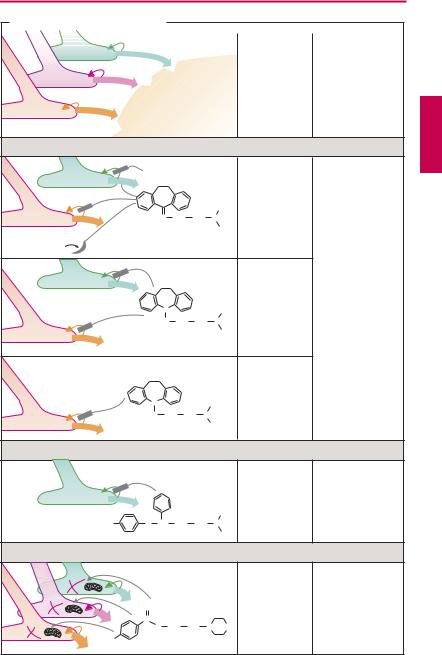
- •Preface to the 3rd edition
- •General Pharmacology
- •Systems Pharmacology
- •Therapy of Selected Diseases
- •Subject Index
- •Abbreviations
- •General Pharmacology
- •History of Pharmacology
- •Drug and Active Principle
- •The Aims of Isolating Active Principles
- •European Plants as Sources of Effective Medicines
- •Drug Development
- •Congeneric Drugs and Name Diversity
- •Oral Dosage Forms
- •Drug Administration by Inhalation
- •Dermatological Agents
- •From Application to Distribution in the Body
- •Potential Targets of Drug Action
- •External Barriers of the Body
- •Blood–Tissue Barriers
- •Membrane Permeation
- •Binding to Plasma Proteins
- •The Liver as an Excretory Organ
- •Biotransformation of Drugs
- •Drug Metabolism by Cytochrome P450
- •The Kidney as an Excretory Organ
- •Presystemic Elimination
- •Drug Concentration in the Body as a Function of Time—First Order (Exponential) Rate Processes
- •Time Course of Drug Concentration in Plasma
- •Time Course of Drug Plasma Levels during Repeated Dosing (A)
- •Time Course of Drug Plasma Levels during Irregular Intake (B)
- •Accumulation: Dose, Dose Interval, and Plasma Level Fluctuation (A)
- •Dose–Response Relationship
- •Concentration–Effect Curves (B)
- •Concentration–Binding Curves
- •Types of Binding Forces
- •Agonists—Antagonists
- •Other Forms of Antagonism
- •Enantioselectivity of Drug Action
- •Receptor Types
- •Undesirable Drug Effects, Side Effects
- •Drug Allergy
- •Cutaneous Reactions
- •Drug Toxicity in Pregnancy and Lactation
- •Pharmacogenetics
- •Placebo (A)
- •Systems Pharmacology
- •Sympathetic Nervous System
- •Structure of the Sympathetic Nervous System
- •Adrenergic Synapse
- •Adrenoceptor Subtypes and Catecholamine Actions
- •Smooth Muscle Effects
- •Cardiostimulation
- •Metabolic Effects
- •Structure–Activity Relationships of Sympathomimetics
- •Indirect Sympathomimetics
- •Types of
- •Antiadrenergics
- •Parasympathetic Nervous System
- •Cholinergic Synapse
- •Parasympathomimetics
- •Parasympatholytics
- •Actions of Nicotine
- •Localization of Nicotinic ACh Receptors
- •Effects of Nicotine on Body Function
- •Aids for Smoking Cessation
- •Consequences of Tobacco Smoking
- •Dopamine
- •Histamine Effects and Their Pharmacological Properties
- •Serotonin
- •Vasodilators—Overview
- •Organic Nitrates
- •Calcium Antagonists
- •ACE Inhibitors
- •Drugs Used to Influence Smooth Muscle Organs
- •Cardiac Drugs
- •Cardiac Glycosides
- •Antiarrhythmic Drugs
- •Drugs for the Treatment of Anemias
- •Iron Compounds
- •Prophylaxis and Therapy of Thromboses
- •Possibilities for Interference (B)
- •Heparin (A)
- •Hirudin and Derivatives (B)
- •Fibrinolytics
- •Intra-arterial Thrombus Formation (A)
- •Formation, Activation, and Aggregation of Platelets (B)
- •Inhibitors of Platelet Aggregation (A)
- •Presystemic Effect of ASA
- •Plasma Volume Expanders
- •Lipid-lowering Agents
- •Diuretics—An Overview
- •NaCl Reabsorption in the Kidney (A)
- •Aquaporins (AQP)
- •Osmotic Diuretics (B)
- •Diuretics of the Sulfonamide Type
- •Potassium-sparing Diuretics (A)
- •Vasopressin and Derivatives (B)
- •Drugs for Gastric and Duodenal Ulcers
- •Laxatives
- •Antidiarrheal Agents
- •Drugs Affecting Motor Function
- •Muscle Relaxants
- •Nondepolarizing Muscle Relaxants
- •Depolarizing Muscle Relaxants
- •Antiparkinsonian Drugs
- •Antiepileptics
- •Pain Mechanisms and Pathways
- •Eicosanoids
- •Antipyretic Analgesics
- •Nonsteroidal Anti-inflammatory Drugs (NSAIDs)
- •Cyclooxygenase (COX) Inhibitors
- •Local Anesthetics
- •Opioid Analgesics—Morphine Type
- •General Anesthesia and General Anesthetic Drugs
- •Inhalational Anesthetics
- •Injectable Anesthetics
- •Sedatives, Hypnotics
- •Benzodiazepines
- •Pharmacokinetics of Benzodiazepines
- •Therapy of Depressive Illness
- •Mania
- •Therapy of Schizophrenia
- •Psychotomimetics (Psychedelics, Hallucinogens)
- •Hypothalamic and Hypophyseal Hormones
- •Thyroid Hormone Therapy
- •Glucocorticoid Therapy
- •Follicular Growth and Ovulation, Estrogen and Progestin Production
- •Oral Contraceptives
- •Antiestrogen and Antiprogestin Active Principles
- •Aromatase Inhibitors
- •Insulin Formulations
- •Treatment of Insulin-dependent Diabetes Mellitus
- •Treatment of Maturity-Onset (Type II) Diabetes Mellitus
- •Oral Antidiabetics
- •Drugs for Maintaining Calcium Homeostasis
- •Drugs for Treating Bacterial Infections
- •Inhibitors of Cell Wall Synthesis
- •Inhibitors of Tetrahydrofolate Synthesis
- •Inhibitors of DNA Function
- •Inhibitors of Protein Synthesis
- •Drugs for Treating Mycobacterial Infections
- •Drugs Used in the Treatment of Fungal Infections
- •Chemotherapy of Viral Infections
- •Drugs for the Treatment of AIDS
- •Drugs for Treating Endoparasitic and Ectoparasitic Infestations
- •Antimalarials
- •Other Tropical Diseases
- •Chemotherapy of Malignant Tumors
- •Targeting of Antineoplastic Drug Action (A)
- •Mechanisms of Resistance to Cytostatics (B)
- •Inhibition of Immune Responses
- •Antidotes and Treatment of Poisonings
- •Therapy of Selected Diseases
- •Hypertension
- •Angina Pectoris
- •Antianginal Drugs
- •Acute Coronary Syndrome— Myocardial Infarction
- •Congestive Heart Failure
- •Hypotension
- •Gout
- •Obesity—Sequelae and Therapeutic Approaches
- •Osteoporosis
- •Rheumatoid Arthritis
- •Migraine
- •Common Cold
- •Atopy and Antiallergic Therapy
- •Bronchial Asthma
- •Emesis
- •Alcohol Abuse
- •Local Treatment of Glaucoma
- •Further Reading
- •Further Reading
- •Picture Credits
- •Drug Indexes

226 Psychopharmacologicals
Therapy of Depressive Illness
The term “depression” is used for a variety of states that are characterized by downswings in mood varying from slight to most severe. The principal types are:
Endogenous depression, ranging from its severe form (major depression) to lighter cases (minor depression)
Dysthymia (neurotic depression)
Reactive depression as (overshooting) reaction to psychic insults or somatic illness
Endogenous depression generally follows a phasic course with intervals of normal mood. When mood swings do not change direction, unipolar depression is said to be present. Bipolar illness designates an alternation between depressive states and manic episodes. Besides devitalizing melancholia with its attendant burden of suffering, the behavior of patients in depression may vary from strongly inhibited to anxious, agitated, guilt-ridden, presuicidal, and so on. Depressive states are frequently associated with somatic symptoms; the patients project their mood disturbance into a physical ailment. Accordingly, many depressive patients initially visit a family physician or internist.
The pharmacotherapy of depression is a dif cult undertaking. At the outset, it is necessary to determine the type of depression. For instance, in neurotic depression, psychotherapy may be suf cient. A reactive mood disorder calls for attempts to establish the causal link. In either condition, temporary use of antidepressants may be warranted. The proper indication for thymoleptics is endogenous depression. However, even for this endogenous psychosis, it is dif cult to evaluate the effectiveness of this drug class. One fundamental reason is the lack of experimental animal models of depression: the ef cacy of drugs cannot be tested in experiments on animals. Moreover, depression is periodic in nature; spontaneous remission nearly always occurs. Intensive psychological support may also sometimes be effective in improving the condition of patients. Ac-
cording to some estimates, one-third oftherapeutic success in moderately severe depression can be attributed to a placebo effect, one-third to intensive support, and the remaining one-thirdto use ofantidepressant agents. In severe depression, pharmacotherapy may achieve somewhat more favorable results. Because objective documentation of therapeutic success is extraordinarily dif - cult, it is hardly surprising that no specific antidepressant has proved superior in comparison with others. About 30% of patients are resistant to currently available drug treatments. A workable general rule would be to prescribe tricyclic compounds (and venlafaxine) for severe depression, and selective serotonin reuptake inhibitors (SSRI) for moderately severe to mild cases. No scientifically convincing evidence is available for the “alternative” phytomedicinal, St. John’s wort (Hypericum perforatum), although drug interactions are well documented.
It would be a major therapeutic error to administer a drive-enhancing drug such as amphetamine to a depressed patient with psychomotor inhibition (A). Suicide would be an expected consequence.
The antidepressant effect of thymoleptics manifests after a prolonged latency; usually 1–3 weeks pass before subjective or objective improvementbecomesnoticeable (A). In contrast, somatic effects are immediately evident; specifically, the interference with neuronal transmitter/modulator systems (norepinephrine, serotonin, acetylcholine, histamine, dopamine). Reuptake of released serotonin, norepinephrine, or both is impaired († elevatedconcentration in synaptic cleft) and/or receptors are blocked (example in A). These effects are demonstrable in animal studies and are the cause of acute adverse effects.
The importance of these phenomena for the antidepressant effect remains unclear. Presumably, adaptation of receptor systems to altered concentrations or actions of transmitter/modulator substances plays a role.

Therapy of Depressive Illness |
227 |
A. Effect of antidepressants
Endogenous |
depression |
|
|
||
|
||
|
|
|
Deficient drive
Normal mood
Normal drive
Week 3
Week 5
Week 7
Week 9
Imipramine
N |
CH3 |
CH2 CH2 CH2 N
CH3
5 HT or NA
|
|
|
|
|
|
|
|
|
|
|
|
|
|
|
|
|
|
|
|
|
|
|
|
|
|
|
|
|
|
|
|
|
|
|
|
|
|
|
|
|
|
|
|
|
|
|
|
M, H1, α 1 |
|
|||||
Inhibition of |
Blockade of |
|
||||||||
re-uptake |
receptors |
|
||||||||
|
|
|
|
|
|
|
|
|
|
|
|
|
|
|
|
|
|
|
|
|
|
|
|
|
|
|
|
|
|
|
|
|
|
|
|
|
|
|
|
|
|
|
|
|
|
|
|
|
|
|
|
|
|
|
|
|
|
|
|
|
|
|
|
|
|
|
|
|
|
|
|
|
|
|
|
|
|
|
|
|
|
|
|
|
|
|
|
|
|
|
|
|
|
|
|
|
|
|
Amphetamine Immediate

228 Psychopharmacologicals
The thymoleptic mechanism of action remains to be elucidated.
Antidepressants can be divided into four groups:
1.Tricyclic antidepressants (A), such as desipramine, amitriptyline, and many analogue substances, possess a hydrophobic ring system. The central 7-membered ring increases the annelation angle between the outer flanking rings. This moiety can also be tetracyclic (e.g., maprotiline). The ring system bears a side chain with a secondary or tertiary amine that can be protonated depending on its pKa value. These substances can thus take on an amphiphilic character, permitting insertion into lipid membranes and enrichment in cellular structures. The basic structure of tricyclic antidepressants also explains their af nity for receptors and transmitter transport mechanisms. Receptor blockade is the chief cause of the adverse effects in this drug group, including: tachycardia, inhibition of glandular secretion (dry mouth), constipation, dif culty in micturition, blurred vision, and orthostatic hypotension (A upper). Asedative action probably arising from antagonism at CNS H1 histamine receptors, as obtained with amitriptyline, can be desirable.
2.Selective serotonin reuptake inhibitors (SSRI). These substances (e.g., fluoxetine) also possess a protonatable nitrogen atom and, instead of a larger ring system, contain simpler aromatic moieties. They also have amphiphilic character. Because their af nity for receptors is much less (no blockade of acetylcholine or norepinephrine receptors), acute adverse effects are less marked than those of tricyclic thymoleptics. Blockade of reuptake is confined to serotonin (5-HT). Antidepressant potency is equal to or slightly inferior to that of tricyclics. Fluoxetine has a long duration of action. Together with its active metabolite, it is eliminated with a half-life of several days. The SSRI group includes several other substances
such as citalopram, paroxetine, sertraline and fluvoxamine. Besides depression, these substances are also marketed for various other psychiatricindications, including anxiety disorders, posttraumatic stress, and ob- sessive-compulsive disorder.
Labeling of most drugs in this group was recently revised to include a warning statement concerning a worsening of depression and treatment-emergent suicidality in both adult and pediatric patients.
3.Inhibitors of monoamine oxidase A (thymeretics). Moclobemide is the only representative of this group. It produces a reversible inhibition of MAOA, which is responsible for inactivation of the amines norepinephrine, dopamine, and serotonin (A). Enzyme inhibition results in an increased concentration of these neurotransmitters in the synaptic cleft. Moclobemide is less effective as an antidepressant than as a psychomotor stimulant. It is indicated only in depressions with extreme psychomotor slowing and is contraindicated in patients at risk of suicide.
Tranylcypromine causes irreversible inhibition ofthe twoisozymesMAOA and0$2% Therefore, presystemic elimination in the liver of biogenic amines, such as tyramine, thatare ingestedin food(e.g.,in aged cheese and Chianti) is impaired (with danger of a diet-induced hypertensive crisis). The compound is obsolete in some countries.
4.Atypical antidepressants represent a heterogeneous group comprising agents that interfere only weakly or not at all with monoamine reuptake (trazodone, nefazodone, bupropion, mirtazapine), preferentially block reuptake of norepinephrine (reboxetine), or act as dual inhibitors of 5-HT and norepinephrine reuptake (venlafaxine, milnacipran, duloxetine). Venlafaxine appears to be as effective as tricyclic antidepressants in severe depression.

|
|
|
|
|
|
|
|
|
|
Antidepressant Drugs |
229 |
|
A. Antidepressants: activity profiles |
|
|
|
|
|
|
|
|
|
|||
|
Serotonin |
|
5-HT-Receptor |
|
|
|
||||||
|
|
|
|
Indication |
Adverse effects |
|
||||||
|
Dopamine |
D-Receptor |
|
|
|
|
|
|
||||
Norepinephrine |
α -Adrenoceptor |
|
|
|
|
|
|
|||||
|
|
|
|
|
|
|
|
|||||
|
|
Tricyclic Antidepressants |
|
|
||||||||
|
|
|
Amitriptyline |
|
Patient: |
Parasympatholytic |
||||||
|
|
|
|
|
|
|
|
|
|
|
effects: |
|
Psychomotor |
|
|
|
|
|
|
|
|
|
|
e.g., tachycardia, |
|
dampening, |
|
|
|
|
|
|
|
|
CH3 |
Anxious, |
||
|
|
|
|
|
|
|
|
dry mouth, |
|
|||
anxiolytic |
|
|
HC |
CH2 |
CH2 |
N |
|
agitated |
constipation, |
|
||
|
central |
|
|
|
|
|
|
|
CH3 |
|
difficult urination |
|
Histamine |
|
|
|
|
|
|
|
|
|
Caution: closed- |
||
H1-Receptor |
|
|
|
|
|
|
|
|
||||
|
|
|
|
|
|
|
|
angle glaucoma |
||||
|
|
|
Imipramine |
|
Patient: |
|
|
|||||
|
|
|
|
|
|
|
|
|
|
|
α 1-Blockade: |
|
|
|
|
N |
|
|
|
|
|
CH3 |
|
orthostatic |
|
|
|
H2C |
CH2 |
CH2 |
N |
Drive |
|
|||||
|
|
hypotension |
|
|||||||||
|
|
|
|
|
|
|
|
|
CH3 |
normal |
|
|
|
|
|
|
|
|
|
|
|
|
|
||
|
|
|
Desipramine |
|
Patient: |
|
|
|||||
Psychomotor |
|
|
|
|
|
|
|
|
|
|
In high dose: |
|
activation |
|
N |
|
|
|
|
|
H |
|
Psychomotor |
cardiodepression |
|
|
|
|
|
|
|
|
|
|
|
|||
|
|
H2C |
CH2 |
CH2 |
N |
|
|
|
||||
|
|
|
inhibition |
|
|
|||||||
|
|
|
|
|
|
|
|
CH3 |
|
|
||
|
|
|
|
|
|
|
|
|
|
|
||
|
Selective Serotonin Reuptake Inhibitors (SSRI) |
|
|
|||||||||
|
|
|
Fluoxetine |
|
|
Patient: |
Akathisia, |
|
||||
|
|
|
|
|
|
|
|
|
|
|
insomnia, |
|
|
|
|
|
|
|
|
|
|
|
|
loss of appetite, |
|
|
|
|
|
|
|
|
|
|
H |
Psychomotor |
weight loss, |
|
|
|
|
|
|
|
|
|
|
suicidal ideation |
|||
|
F3C |
O |
CH |
CH2 |
CH2 |
N |
|
|||||
|
|
inhibition |
|
|
||||||||
|
|
|
|
|
|
|
|
|
CH3 |
|
|
|
|
|
|
MAOA Inhibitors |
|
|
|
||||||
|
|
|
Moclobemide |
Patient: |
|
|
||||||
|
MAO |
|
|
|
|
|
|
|
|
|
In hypertonic |
|
|
|
|
|
|
|
|
|
|
|
|
patients: |
|
MAO |
O |
|
|
|
|
|
|
|
Psychomotor |
Caution: biogenic |
||
|
|
C |
|
|
|
|
|
|
|
amines in food |
|
|
MAO |
|
N |
CH2 |
|
CH2 |
|
N |
O |
inhibition |
|
|
|
Cl |
H |
|
|
|
|
|
|
|
|
|
||
|
|
|
|
|
|
|
|
|
|
|
|
|
